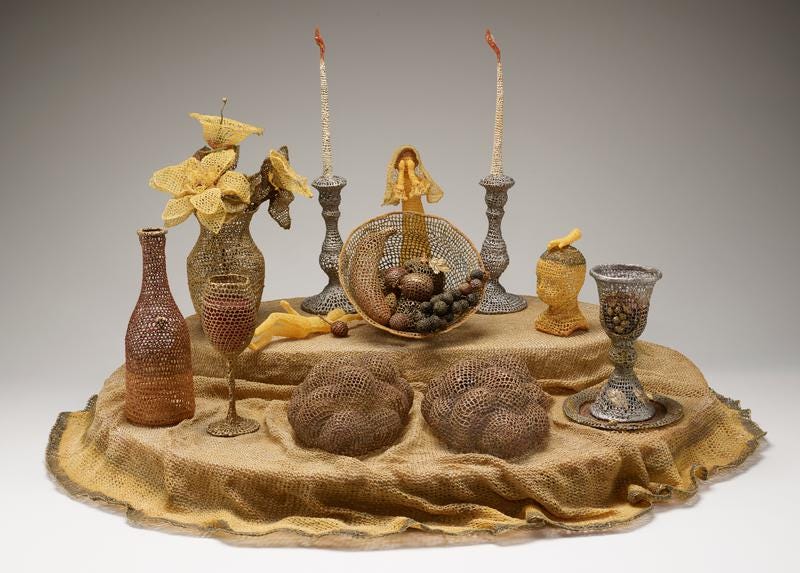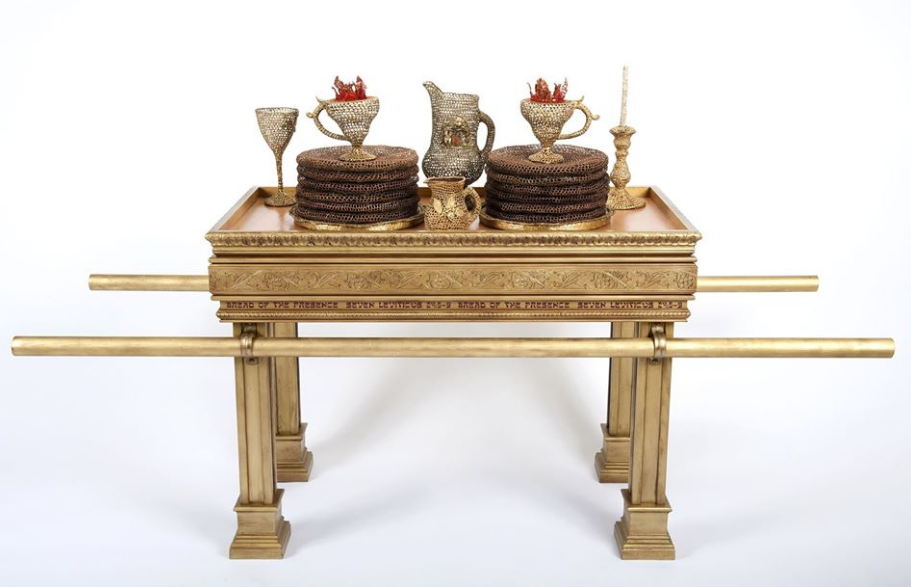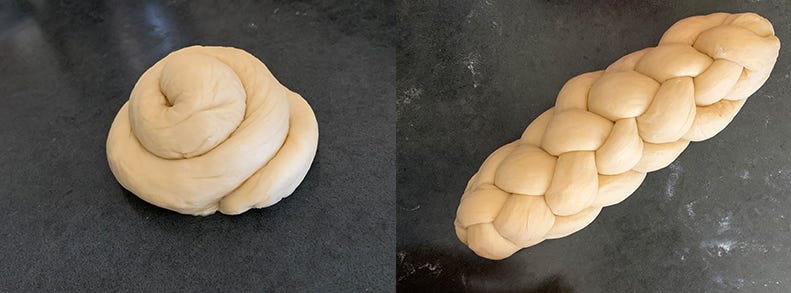The Sabbath Now Minneapolis Institute of Art October 20
Craftibaking
Let Challah Ease Your Pandemic Feet

By Nicole LaBouff
Maybe you are still getting through this pandemic by distractibaking. Or maybe you lot take decided that staff of life is over and have turned to knitting, crochet, and other crafts as a way to calm your nerves. If either — or none — of these applies, you lot might desire to consider braiding challah, a practice that brings the culinary and cobweb arts together in one therapeutic pastime that lets you accept your arts and crafts and eat it too. You might call it craftibaking.
If you are new to the joys of braiding challah, some seize with teeth-sized tutorials courtesy of Rabbi Alexander Davis from Beth El Synagogue in St. Louis Park will get you started. I met Rabbi Davis last year equally I planned the display for a newly caused sculpture, The Sabbath At present (shown higher up), which is nevertheless on view, in the night, backside the closed doors of Mia. This work is the creation of fiber artist Norma Minkowitz, best known for her transparent crochet sculptures. The Sabbath Now, forth with its companion, The Sabbath So, which belongs to the Museum of Fine Arts, Boston, explores the tradition of the Jewish Sabbath from ancient times when it was associated with Temple worship to the domestic family repast that continues today.
Though I initially consulted Rabbi Davis for help with editing the gallery console text, he kindly offered his aid with a public program nosotros held concluding Oct in celebration of the new installation. Along with Norma Minkowitz's discussion of her work, Davis suggested he offering some lessons in challah braiding. Given that The Sabbath At present sculpture includes ii crocheted loaves of braided challah, the connectedness seemed clear. And when Davis explained that he liked to weave theological discussion throughout his cooking demonstrations, his educational approach seemed especially apt. Minkowitz was raised in a non-religious Jewish household where Sabbath celebrations were uncommon. Her procedure began with research, and she approached her sculptures as an outsider curious well-nigh a custom that was at in one case familiar and foreign.

In our gimmicky moment, when large public gatherings are prohibited in places of worship and everywhere else, challah may be even more than resonant. According to Davis, Jewish worshipers in aboriginal times were required to give a portion of dough to priests as a class of taxation, while the priests in turn offered stacks of flatbreads called matzot to the congregation on the Sabbath — as depicted in Minkowitz's The Sabbath Then. Just after the destruction of the Second Temple in Jerusalem, well-nigh 2000 years ago, the baking of bread for holy 24-hour interval celebrations shifted from the temple to the domicile.
Today, the ancient practices of public offerings and sharing bounty are still acknowledged in domestic contexts by twisting off a small portion of the challah dough — a morsel chosen the "challah" — before shaping and baking it. That flake is placed in the oven to burn, symbolically destroyed in keeping with the requirement of the temple tithe. As Rabbi Davis points out, this human activity as well prompts generosity in a broader sense: "When I brand challah, I get so excited to dig into the dough — my kickoff impulse is to receive. But trigger-happy off that showtime portion reminds me of the commandment to give."
The shift from unleavened matzot to the raised braided challah common today happened during the 1400s in Eastern Europe, every bit Ashkenazi Jews adopted local baking traditions. There were no rules around braided designs, though the numbers of strands often held religious significance. Mostly, people improvised.

If you experience like improvising, here are some quick tutorials courtesy of Rabbi Davis, followed by his favorite challah recipe.
First, a quick lesson in rolling out the challah dough:
Side by side, the classic three-braid challah:
At present, accept things up a notch with a v-complect challah:
A variation on the five-braid challah:
The six-braid challah (yes, you can do this):
Finally, the classic round challah, now most ofttimes made for Rosh Hashanah:
Recipe adapted from Jewish Cooking past Gil Marks:
Makes 2 medium loaves
Ingredients
1 cup h2o
Pinch of sugar or drop of honey
1 package (2 ½ tsp) yeast
¼ cup vegetable oil
½ cup sugar
2 eggs
½ Tbsp common salt (1 ½ tsp kosher table salt)
4 cups all-purpose flour
Egg launder (beat egg and 1 Tbsp water)
Toppings (i.e., poppy/sesame seeds) as desired
Procedure
Proof yeast in water with sugar or dear, 5 minutes.
Stir in oil, sugar and eggs. Then mix in flour and common salt.
Knead until smooth and rubberband, 10 minutes.
Permit rise, covered in an oiled basin, 2 hours.
Complect and place on baking canvass lined with parchment paper.
Allow rise roughly 45 minutes until double in majority.
Brush with egg wash. Sprinkle on toppings every bit desired.
Bake in a pre-heated 350 oven, xxx minutes.
After 20 minutes, Rotate pan and brush with additional egg wash every bit necessary. Done when sounds hollow and is nicely browned.
Note: you lot can brand the dough and let it ascent, refrigerated overnight. In the morning, shape and let rise. This rising will take around 11/2 hours.
Source: https://medium.com/minneapolis-institute-of-art/craftibaking-ae32b3bf79f3
0 Response to "The Sabbath Now Minneapolis Institute of Art October 20"
Publicar un comentario